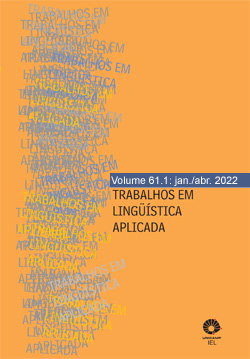Resumen
Nuestro ensayo busca presentar la situación actual de la comunicación durante la pandemia de Covid-19 en Brasil. Nuestro principal objetivo es iniciar un debate sobre cómo las instituciones públicas garantizan el acceso a este tipo de información. A la hora de hacer un análisis crítico de la situación, este artículo muestra la importancia de los traductores e intérpretes a la hora de informar noticias durante una pandemia, para que las personas sordas puedan obtener información sin demora. Esto también le permite evitar las noticias falsas, cruciales en todas las circunstancias. Se presentaron algunas consideraciones sobre cómo estas instituciones pueden financiar a los profesionales, utilizando medios legales por parte de la comunidad, con el fin de fortalecer sus derechos.
Citas
AMORIM, G.; RAMOS, A. S. L.; JÚNIOR, G. C.; AFONSO, L. S.; CASTRO, H. C. (2020). Coronavirus Deafness and the Use of Different Signs of the Area in Health During a Period of Pandemic Time: Is That the Best Option to Do? Creative Education. vol. 11, nº 4, pp. 573-580.
BERGHEL, H. (2017). Lies, Damn Lies, and Fake News. IEEE Xplore. vol. 50, nº 2, pp. 80-85.
BITTENCOURT, Z. Z. L. de C., FRANCOZO, M. F. C., MONTEIRO, C. R., FRANCISCO, D. D. (2011). Deafness, Social Network and Social Protection. Ciência & Saúde Coletiva. vol. 16, nº 1, pp. 769-776.
BRAZIL. Art. 5 Dos Direitos e Garantias Fundamentais, Constituição., 1988. Constituição [da] República Federativa do Brasil, Senado Federal, DF, 1988.
BRAZIL. Decreto-lei nº 7713, de 22 de dezembro de 1988. Diário oficial [da] República Federativa do Brasil, Poder Executivo, DF, 22 de Dez. 1988.
BRAZIL. Decreto-lei nº 3298, de 20 de dezembro de 1999. Diário oficial [da] República Federativa do Brasil, Poder Executivo, DF, 20 de Dez. 1999.
BRAZIL. Decreto-lei nº 10436, de 24 de abril de 2002. Diário oficial [da] República Federativa do Brasil, Poder Executivo, Brasília, DF, 20 de abr. 2002.
BRAZIL. Decreto-lei nº 12319, de 11 de setembro de 2010. Diário oficial [da] República Federativa do Brasil, Poder Executivo, Brasília, DF, 11 de set. 2010.
BRAZIL. 1988. Constituição da República Federativa do Brasil. Brasília: Senado Brasileiro.
BRAZIL. Projeto-lei nº 6990, de 17 de março de 2010. Câmara Federal [da] República Federativa do Brasil, Poder Legislativo, Brasília, DF, 17 de mar. 2010.
CARSLON, M. (2020). Fake News as an Informational Moral Panic: the Symbolic Deviancy of Social Media During the 2016 US Presidential Election. Information, Communication & Society. vol. 23 nº 3, pp. 374-388.
DECLECQ, M. (2020). Informações Essenciais sobre Novo Coronavirus não Chegam para os Surdos. Folha de São Paulo, São Paulo. Disponível em: https://tab.uol.com.br/noticias/redacao/2020/04/02/a-maioria-das-informacoes-sobre-a-covid-19-nao-chegam-para-os-surdos.htm Acesso em 2 de abr. 2020.
FARJADO, I.; VIGO, M.; SALMERÓN, L. (2009). Technology for Supporting Web Information Search and Learning in Sign Language. Interacting with Computers. vol. 21, nº 4, pp. 243-256.
FAPESP. (2020). Laboratório da UFSCar produz material sobre prevenção da COVID-19 em Libras. FAPESP, São Paulo. Disponível em: http://agencia.fapesp.br/laboratorio-da-ufscar-produz-material-sobre-prevencao-da-covid-19-em-libras/33118/ Acesso em: 8 de mai. 2020.
FEBRAPELIS. (2019). Nota de Esclarecimento. FEBRAPILS, Rio de Janeiro. Disponível em: http://febrapils.org.br/nota-de-esclarecimento/ Acesso em: 15 de mar. 2020.
CORPO EDITORIAL. (2020). Estudantes Criam Site que Informa sobre Covid-19 na Língua dos Surdos. GAZETA DO POVO, Curitiba. Disponível em: https://www.gazetadopovo.com.br/parana/covid-19-estudantes-da-pucpr-criam-site-com-informacoes-a-surdos/ Acesso em: 1 de mai. 2020.
HAMMERSTEIN, L. VON. (2020). How Germany’s Fight Against Coronavirus Excludes the Deaf. DW, Berlin. Disponível em: https://www.dw.com/en/how-germanys-fight-against-coronavirus-excludes-the-deaf/a-52787476 Acesso em: 16 de mar. 2020.
IBGE. (2010). Pessoas com Deficiência. Secretaria Nacional de Promoção dos Direitos da Pessoa com Deficiência. Disponível em: http://www.pessoacomdeficiencia.gov.br/app/sites/def ault/files/publicacoes/cartilha-censo-2010-pessoas-com-deficienciareduzido.pdf. Acesso em: 15 de mai. 2020
KELMAN, C. A.; SILVA; D. N. H.; AMORIM, A. C. F.; MONTEIRO, R. M. G.; AZEVEDO, D. C. (2011). Deafness and Family: Aspects of Parental relationships in Daily Bilingual Communication. Linhas Críticas. vol. 17, nº 33, pp. 341-365.
LORENTZ, B. (2020). Intérpretes de Libras da Live de Marília Mendonça fala sobre Repercussão após Performance. O Globo, Rio de Janeiro. Disponível em: https://g1.globo.com/pop-arte/musica/noticia/2020/04/10/interprete-de-libras-da-live-de-marilia-mendonca-fala-sobre-repercussao-apos-performance.ghtml Acesso em: 11 de abr. 2020.
NAPIER, J.; SKINNER, R.; TURNER, G.H. (2017). “It’s Good for Them But Not So For Me”: Insight the Sign Language Interpreting Call Centre. The International Journal for Translation & Interpreting Research. vol. 9, nº 2, pp. 1-23.
NAPIER, J.; LLPYD, K.; SKINNER, R.; TURNER, G. H.; WHEATLEY, M. (2018). Using Video Technology to Engage Deaf Sign Language Users in Survey Research: An Example From the insight Project. The International Journal for Translation & Interpreting Research. vol. 10, nº 2, pp. 101-121.
PAIVA, V. L. M. de O.; PAGANO, A. S. (2001). English in Brazil with an Outlook on its Function as a Language of Science; The Dominance of English as a Language of Science: Effects on Other Language and Language Communities. Berlin: De Gruyter Mouton.
SCOTT, G. A. (2011). Deaf and Hard of Hearing Children: Federal Support for Developing Language and Literacy. Hilights of GAO. Pp. 1-26.
STADEN, A.; BADENHORST, G.; RIDGE, E. (2008). The Benefits of Sign Language for Deaf Learners with Language Challenges. Per Linguan. vol. 25, nº 1, pp. 44-60.
WELSH, W. A. (2019). The Economic Impact of the Deafness. Jadara. vol. 24, nº 3, pp. 72-80.
WORLD HEALTH ORGANIZATION. (2020). Deafness and Hearing Loss. Disponível em: https://www.who.int/health-topics/hearing-loss#tab=tab_1 Acesso em: 22 de abr. 2020
YUE, A. H. (20100. Intervenção bilíngue: percepção dos pais quanto a mudanças na comunicação com seus filhos surdos. Dissertação de Mestrado em Medicína, Faculdade de Medicina, Universidade de São Paulo, São Paulo, SP, Brasil.
ZHANG, X., GHORBANI, A. A. (2020). An Overview of Online Fake News: Characterization, Detection, and Discussion. Information Processing & Management. vol. 57, nº 2, pp. 1-26.

Esta obra está bajo una licencia internacional Creative Commons Atribución 4.0.
Derechos de autor 2022 Trabalhos em Linguística Aplicada


